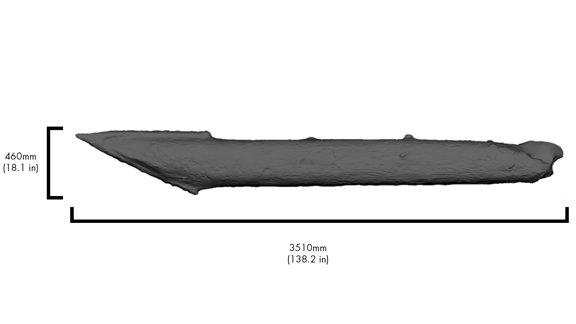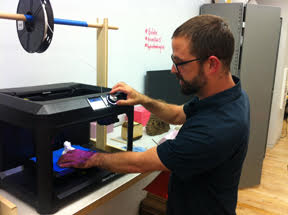Erik Sundquist – Day of Archaeology, 2015
back to 2015 Day of Archaeology Index
See Past Days of Archaeology in Philadelphia (2014, 2013, 2012)
Back to PAF HOME
~~~
Digital Reproduction and Fabrication
By Erik Sundquist
Director of the Hybrid Making Labhttps://www.phillyarchaeology.net/5558-2/
Antoinette Westphal College of Media Arts & Design
Drexel University, Philadelphia, Pennsylvania (USA)
As the Director of the Hybrid Making Lab and fabrication facilities at Drexel University’s Antoinette Westphal College of Media Arts & Design, I closely work with both students and faculty. Today I conferred with Digital Media sophomore Riley Stewart and Digital Media faculty member Glen Muschio. Riley is cutting a foam replica of the archaeological remains of a cheval de frise, an American Revolution era underwater defense weapon recovered from the Delaware River several years ago. The replica will be used as a stand-in for the actual artifact as Craig Bruns, Curator of the Independence Seaport Museum, Philadelphia prepares an exhibit featuring the actual artifact. The 11ft. section of the cheval consists of a tree log with an iron tip. The artifact is very fragile and the stand-in will be used to prepare for the exhibit. Glen Muschio and his students digitized the cheval for the Seaport Museum in 2007. When Glen approached the fabrication lab for help to replicate the cheval using the 3D scan documentation, I was both excited and intrigued by the prospects of our fabrications facilities taking part in an Archeology project.
After some conversation we decided to fabricate a full size replica of the cheval out of high density foam using CNC (Computer Numerical Control ) routing technology. CNC routing technology enables us to reproduce three dimensional files of objects by calculating tool paths over the surface area of the objects. In this case, the high resolution 3D scan of the cheval was split into several parts to accommodate the limits of the CNC routing table. The piece is being routed out at a high resolution so it will properly reproduce the intricacies and textures of the cheval’s surface. The piece was produced in sections and assembled to create a full and accurate tree dimensional replica of the artifact.
The cheval project has opened possibilities for further fabrication lab collaborations in archaeology and cultural heritage. We are currently working with Glen on the possibilities of reproducing various archaeological artifacts for both research and educational purposes. In the area of cultural heritage, we have also begun to digitally scan and reproduce artifacts for Westphal College’s Robert and Penny Fox Historic Costume Collection. The Collection preserves thousands of historically significant garments and accessories. These projects show how relatively new, but very accessible technologies can help in the preservation of archaeological and historical artifacts, while making them accessible to researchers, preservationists, educators and the general public.
by admin

